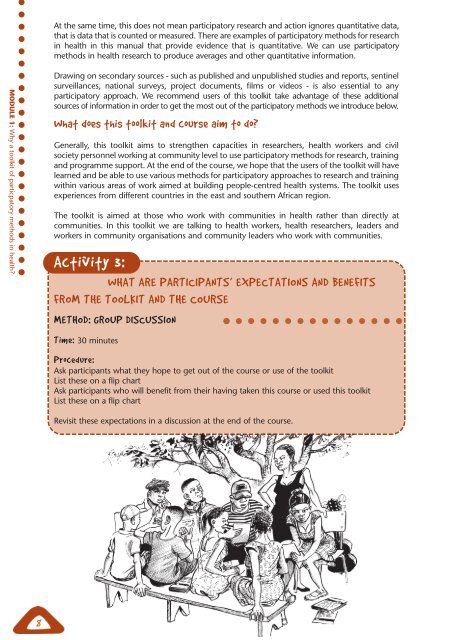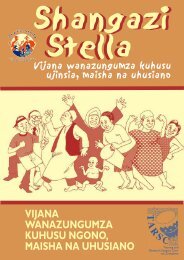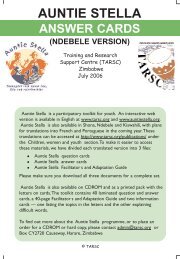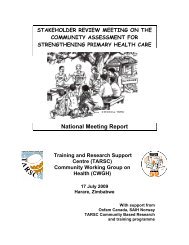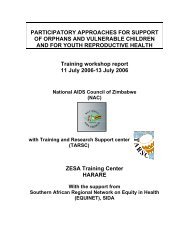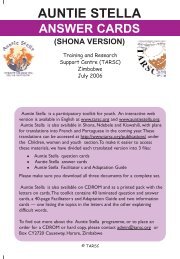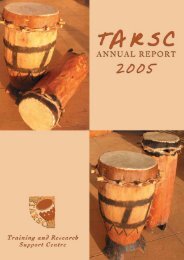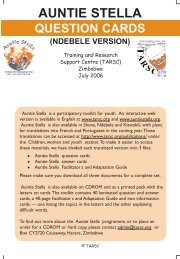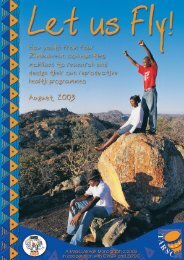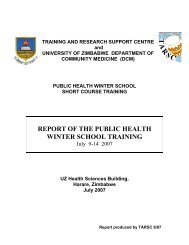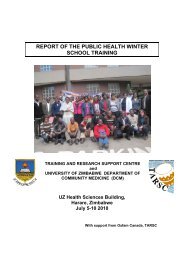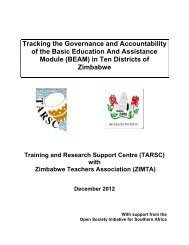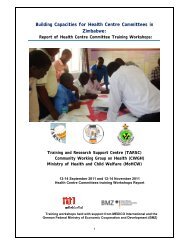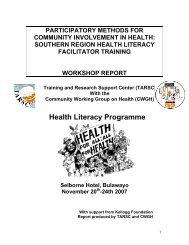PRA toolkit sample.pdf - Training and Research Support Centre
PRA toolkit sample.pdf - Training and Research Support Centre
PRA toolkit sample.pdf - Training and Research Support Centre
You also want an ePaper? Increase the reach of your titles
YUMPU automatically turns print PDFs into web optimized ePapers that Google loves.
At the same time, this does not mean participatory research <strong>and</strong> action ignores quantitative data,<br />
that is data that is counted or measured. There are examples of participatory methods for research<br />
in health in this manual that provide evidence that is quantitative. We can use participatory<br />
methods in health research to produce averages <strong>and</strong> other quantitative information.<br />
MODULE 1: Why a <strong>toolkit</strong> of particpatory methods in health?<br />
Drawing on secondary sources - such as published <strong>and</strong> unpublished studies <strong>and</strong> reports, sentinel<br />
surveillances, national surveys, project documents, films or videos - is also essential to any<br />
participatory approach. We recommend users of this <strong>toolkit</strong> take advantage of these additional<br />
sources of information in order to get the most out of the participatory methods we introduce below.<br />
What does this <strong>toolkit</strong> <strong>and</strong> course aim to do?<br />
Generally, this <strong>toolkit</strong> aims to strengthen capacities in researchers, health workers <strong>and</strong> civil<br />
society personnel working at community level to use participatory methods for research, training<br />
<strong>and</strong> programme support. At the end of the course, we hope that the users of the <strong>toolkit</strong> will have<br />
learned <strong>and</strong> be able to use various methods for participatory approaches to research <strong>and</strong> training<br />
within various areas of work aimed at building people-centred health systems. The <strong>toolkit</strong> uses<br />
experiences from different countries in the east <strong>and</strong> southern African region.<br />
The <strong>toolkit</strong> is aimed at those who work with communities in health rather than directly at<br />
communities. In this <strong>toolkit</strong> we are talking to health workers, health researchers, leaders <strong>and</strong><br />
workers in community organisations <strong>and</strong> community leaders who work with communities.<br />
Activity 3:<br />
WHAT ARE PARTICIPANTS’ EXPECTATIONS AND BENEFITS<br />
FROM THE TOOLKIT AND THE COURSE<br />
METHOD: GROUP DISCUSSION<br />
Time: 30 minutes<br />
Procedure:<br />
Ask participants what they hope to get out of the course or use of the <strong>toolkit</strong><br />
List these on a flip chart<br />
Ask participants who will benefit from their having taken this course or used this <strong>toolkit</strong><br />
List these on a flip chart<br />
Revisit these expectations in a discussion at the end of the course.<br />
8


